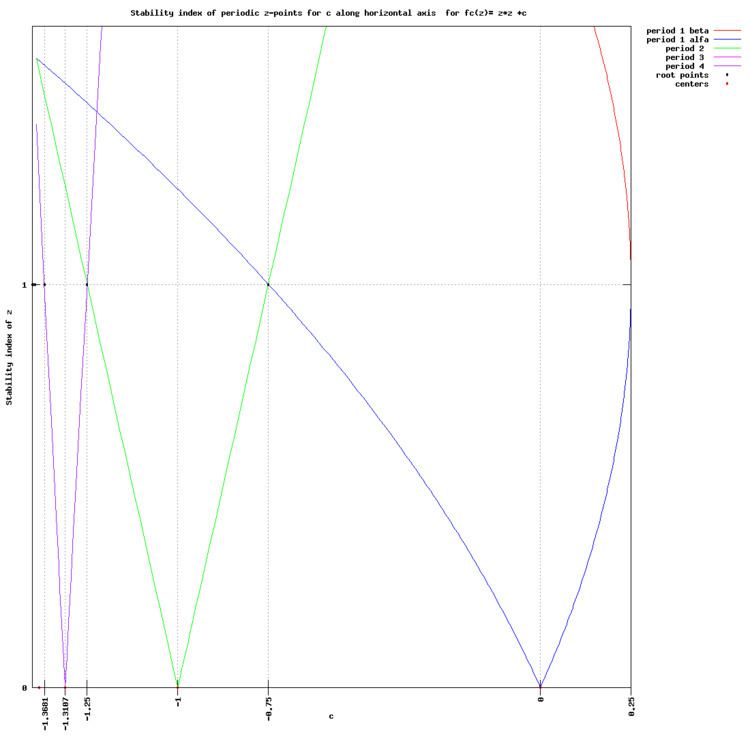 | ||
This article describes periodic points of some complex quadratic maps. A map is a formula for computing a value of a variable based on its own previous value or values; a quadratic map is one that involves the previous value raised to the powers one and two; and a complex map is one in which the variable and the parameters are complex numbers. A periodic point of a map is a value of the variable that occurs repeatedly after intervals of a fixed length.
Contents
- Definitions
- Stability of periodic points orbit multiplier
- Finite fixed points
- Complex dynamics
- Special cases
- Only one fixed point
- Infinite fixed point
- Period 2 cycles
- First method of factorization
- Second method of factorization
- Cycles for period greater than 2
- References
These periodic points play a role in the theories of Fatou and Julia sets.
Definitions
Let
be the complex quadric mapping, where
Notationally,
Periodic points of a complex quadratic mapping of period
where
We can introduce a new function:
so periodic points are zeros of function
which is a polynomial of degree
Stability of periodic points (orbit) - multiplier
The multiplier (or eigenvalue, derivative)
where
Because the multiplier is the same at all periodic points on a given orbit, it is called a multiplier of the periodic orbit.
The multiplier is:
A periodic point is
Periodic points
Finite fixed points
Let us begin by finding all finite points left unchanged by one application of
which can be rewritten as
Since this is an ordinary quadratic equation in one unknown, we can apply the standard quadratic solution formula:
So for
Since
then
Thus fixed points are symmetrical around
Complex dynamics
Here different notation is commonly used:
and
Using Viète's formulas one can show that:
Since the derivative with respect to z is
then
This implies that
These points are distinguished by the facts that:
Special cases
An important case of the quadratic mapping is
Only one fixed point
We have
Infinite fixed point
We can extend the complex plane
and extending polynomial
Then infinity is :
Period-2 cycles
Period-2 cycles are two distinct points
We write
Equating this to z, we obtain
This equation is a polynomial of degree 4, and so has four (possibly non-distinct) solutions. However, we already know two of the solutions. They are
Our 4th-order polynomial can therefore be factored in 2 ways:
First method of factorization
This expands directly as
We already have two solutions, and only need the other two. Hence the problem is equivalent to solving a quadratic polynomial. In particular, note that
and
Adding these to the above, we get
From this, we easily get
From here, we construct a quadratic equation with
Closer examination shows that :
meaning these two points are the two points on a single period-2 cycle.
Second method of factorization
We can factor the quartic by using polynomial long division to divide out the factors
The roots of the first factor are the two fixed points. They are repelling outside the main cardioid.
The second factor has the two roots
These two roots, which are the same as those found by the first method, form the period-2 orbit.
Special cases
Again, let us look at
both of which are complex numbers. We have
Cycles for period greater than 2
The degree of the equation
There is no general solution in radicals to polynomial equations of degree five or higher, so the points on a cycle of period greater than 2 must in general be computed using numerical methods. However, in the specific case of period 4 the cyclical points have lengthy expressions in radicals.
In the case c = –2, trigonometric solutions exist for the periodic points of all periods. The case
